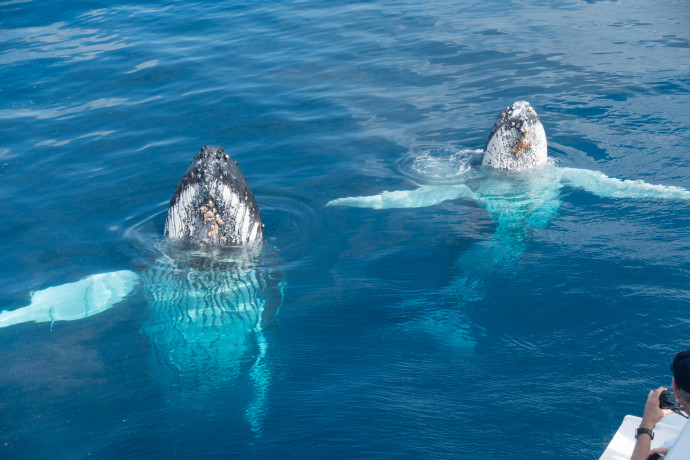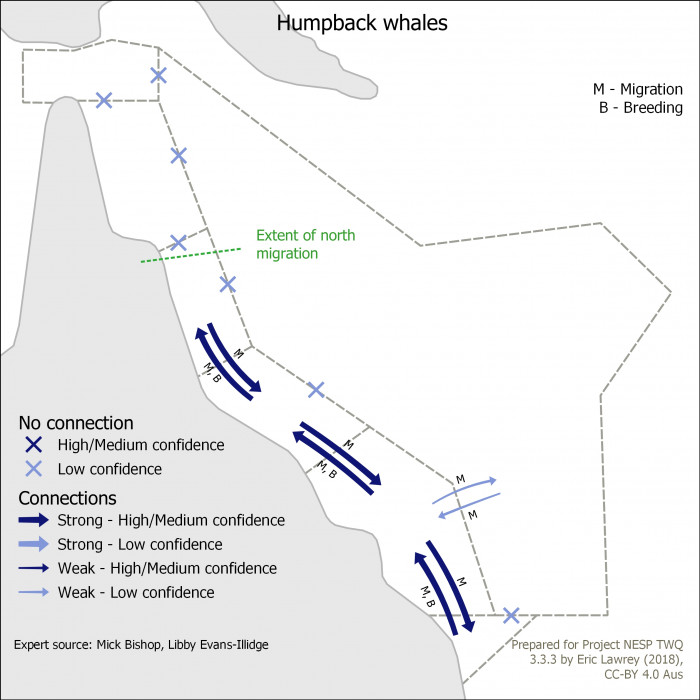Humpback whales
Humpback whales are iconic megafauna that play a significant role in the northeast Australian seascape in ecological, cultural and economic contexts. Some species of whales support active tourist industries, such as whale watch operations for dwarf minke whales in the northern GBR and humpback whales in the Whitsunday Islands. Australia also has legal obligations to protect marine mammals under the federal Environment Protection and Biodiversity Conservation Act (2009), the Great Barrier Reef Marine Park Act (1975) and the Queensland Nature Conservation Act (1992), as well as international obligations under various conventions and agreements.
Key concepts that relate to connectivity
Humpback whales are known to migrate between the GBR and Hervey Bay as part of their northern migration. These whales form part of the Group E breeding stock, members of which generally feed in Area V in Antarctica and migrate along the eastern Australian coast to the GBR to mate and give birth. Satellite tracking of a small sample of 12 whales suggests that they migrate north to the GBR along the eastern edge of Fraser Island (Smith et al. 2012). Hervey Bay is an important stop for humpback whales on their return journey from the GBR to Antarctica.
Along the east coast of Australia, the humpback whale migration occurs between April and November. Breeding and calving in the GBR occurs from June to September (Smith et al. 2012). Warm, comparatively shallow (< 100 m depth) waters are preferred by humpbacks for breeding and calving areas. Spatial distribution models of humpback whales in the GBR have identified the likely breeding ground to be reefs ~100 km east of Proserpine south to Mackay. Individual humpback whales have also been documented moving between Hervey Bay and New Caledonia so it is very likely that animals also move between the GBR and the Coral Sea.
References
Marsh, H. (2008) Marine mammals. In: A Field guide to the Great Barrier Reef, Hutchings, P., Kingsford, M., Hoegh Guldberg, O. (Editors), CSIRO Publishing, 350-358.
Noad, M.J., Dunlop, R.A., Paton, D.A.V.I.D., Cato, D.H. (2008) An update of the east Australian humpback whale population (E1) rate of increase. Santiago Paper submitted to the International Whaling Commission Scientific Committee, 1-13.
Noad, M.J., Dunlop, R.A., Paton, D., Cato, D. H. (2011) Absolute and relative abundance estimates of Australian east coast humpback whales (Megaptera novaeangliae). Journal of Cetacean Research and Management, Special Issue 3, 243-252.
Noad M.J., Dunlop R.A., Bennett, L., Kniest H. (2016) Abundance estimates of the east Australian humpback whale population (BSE1): 2015 survey and update. Paper SC/66b/SH21 presented to the IWC Scientific Committee.
Smith, J.N., Grantham, H.S., Gales, N., Double, M.C., Noad, M.J., Paton, D. (2012) Identification of humpback whale breeding and calving habitat in the Great Barrier Reef. Marine Ecology Progress Series, 447, 259-272.






